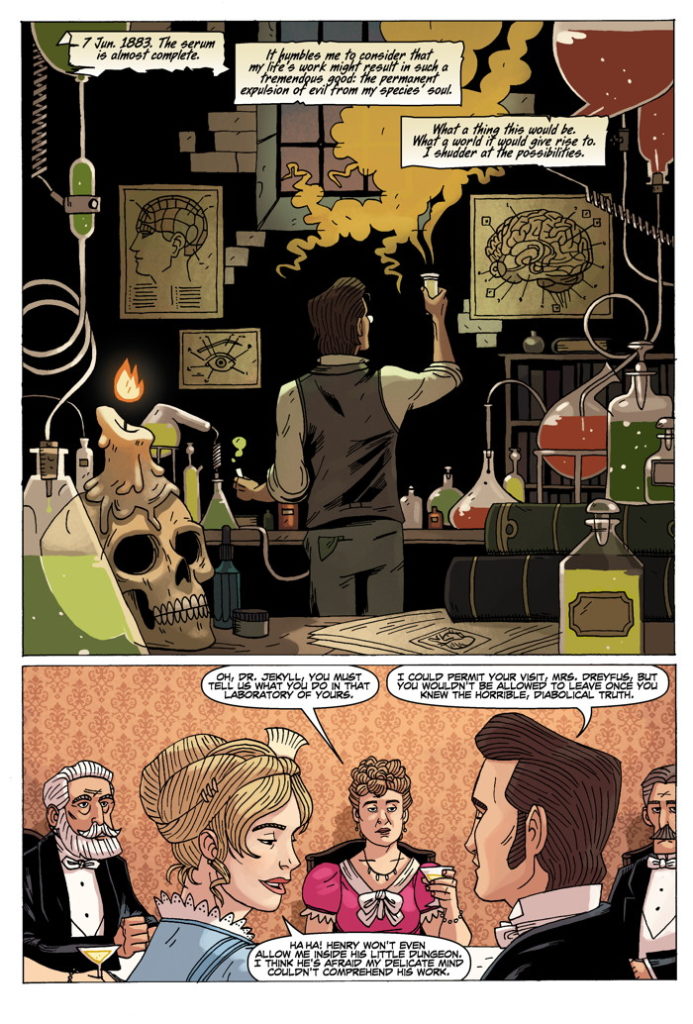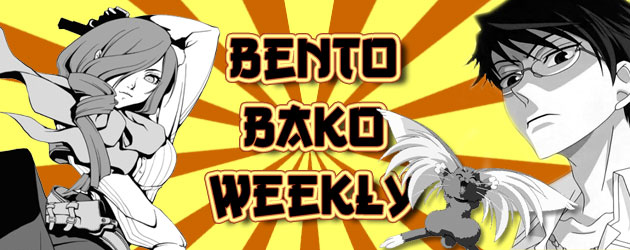Hey everyone! I was recently so fortunate as to pick the brain of Cole Haddon, the writer and mind behind Dark Horse’s upcoming comic, The Strange Case of Mr. Hyde.
 COMIC ATTACK: What inspired you to start writing The Strange Case of Mr. Hyde?
COMIC ATTACK: What inspired you to start writing The Strange Case of Mr. Hyde?
COLE HADDON: Mr. Hyde has always been my favorite Victorian literary villain, more so than all the traditional biggies like Dracula, Frankenstein’s monster, or the Invisible Man. I think I’ve always been fascinated by the fact that, out of all of the so-called villains of the era, he was really the only one who became a villain by virtue of grace. Dr. Jekyll was trying to cure the world of evil, but couldn’t accept the fact that his ego had to be out of control if he assumed himself capable of such a feat. But he started off trying to be the savior only to become the monster, that’s what matters. I wanted to find a way to continue that story, to find out what would happen to a man who had faced such horrible truths about himself and, by extension, the society – specifically the upper-class society – he lived in. I figured such a man, who had seen what the world really was, would have some fascinating insights to share that might hold resonance in our world today. Also, in the most ambitious sense, I really wanted to remind people that Mr. Hyde isn’t a secondary villain. He’s not a gag as he’s often been reduced to. He’s the baddest of the bad in the monster pantheon, a physical and intellectual titan.
CA: Which moments in the book were your favorite to write, and which were the most difficult to pen?
CH: I think my answer is the same for both parts of that question: the conversations – or rather debates – that my protagonist, Inspector Thomas Adye, has with Dr. Jekyll during the first two issues. These largely take place while Jekyll is still imprisoned in one form or another and were, for me, intellectual and spiritual flirtation by way of antagonism. They’re two polar opposites in many ways, learning to appreciate the other through arguments about those differences. I’ve often called STRANGE CASE a bro-mance, and those first couple of issues were a blast to write, showing these two “falling” for each other.
CA: Was there anyone that helped inspire the character of Inspector Adye?
CH: I think probably myself, I’m embarrassed to say. I grew up with a belief structure very much like Adye’s, or at least inculcated in a belief system that didn’t really allow for things like scientific or even rudimentary intellectual curiosity. Certainly not an environment for questioning the reality I was told I lived in. Luckily, I had a series of encounters with books, cinema, and individuals that challenged me to stop trying to make that which didn’t fit into my belief system fit by justifying this or looking at that from a different point of view. It was all desperate scrabbling to hold onto beliefs that no longer made any sense to me, if they ever did. I think Dr. Jekyll represents that dissent to me, that need to question what you believe, why you believe it, and especially who proscribes what you believe. What were their motivations and what are the motivations of those who manipulate you via your beliefs? I’m not necessarily talking theology here. I’m talking politics, economics, et cetera. The whole system. Dr. Jekyll wants to set Adye free, but that doesn’t necessarily mean he, like those other forces I described, doesn’t have his own skewed motivations.
CA: How well does the art in the book reflect the image you had in your head while writing?
CH: M.S. Corley had the not-so-easy task of bringing to life, or at least to the page, what has, for two years, existed primarily in my head. When I picked him to illustrate STRANGE CASE, with the help of my kick-ass editor Dave Land, I had high hopes and low expectations. I never really doubted he’d deliver something in the realm of what I was hoping for, but he did far more than that. I still remember checking out the first few pages he illustrated. Tears came to my eyes because, right there on the page, was exactly what I saw when I wrote the damn script. I mean, he even nailed small tics like how Adye fidgets with his bowler when in an awkward situation. That’s not an easy bit of body language to convey, but he just kills it. Then Jim Gibbons, our colorist, came aboard and just took Corley’s work to a whole other level. The amount of detail he packed in, from things like smoke damage from candles to discoloration of wall paper to Adye’s incredibly varied and vain collection of patterned vests, is just mind-boggling. For four months now, as I looked through their work, I’ve pretty much assumed nothing I wrote could equal the beauty of what these two have produced. Of course, every parent thinks their baby is the smartest baby in a crowded nursery, but, at least artistically, I think this comic book is up there.
CA: It’s common knowledge that Dr. Jekyll/Mr. Hyde is a fictional character, but while the details are sketchy, Jack the Ripper was not. Was it more difficult to work on the fictional or historical characters?
CH: In the Robert Louis Stevenson novel, Mr. Hyde existed as a foil to Dr. Jekyll. I needed a foil for my Dr. Jekyll/Mr. Hyde character as well and Jack the Ripper – London’s other great villain of the era – fit the bill perfectly. However, beyond staying true to the historical details of the murders – when, who, and how – I largely had to reinvent who the Ripper was in order to make him the best possible foil. In other words, I made him up. It’s not From Hell, in that regard. Alan Moore wanted to create a plausible history of the events, derived from historical evidence and theory, but that wasn’t my inclination at all. My inclination was just to write a bad-ass monster-on-monster book with some interesting underlying ideas.
 CA: What sources did you use in your research of the history of Jack the Ripper?
CA: What sources did you use in your research of the history of Jack the Ripper?
CH: I’ve read several books over the years, out of general interest. There’s also a brilliant website devoted to the case called http://www.casebook.org. In addition, for anyone interested in the reality of life in England during the Ripper’s so-called “Autumn of Terror,” check out The Victorian Dictionary at http://www.victorianlondon.org. Once you start wandering around the sites, you won’t be able to stop.
CA: Are there any theories about who Jack the Ripper really was that you believe or find particularly interesting?
CH: I propose one in STRANGE CASE, as revealed in the fourth and final issue. Sorry, that was just shameless self-promotion. Honestly, there are too many theories to pick from.
CA: Are you a Robert Louis Stevenson fan? What other literary classics are you fond of?
CH: I’m a devotee of all Victorian adventure and horror fiction, including Stevenson. I’m particularly fond of the monster stuff, as I said, like Dracula, The Invisible Man, Frankenstein, The Island of Dr. Moreau, and, of course, The Strange Case of Dr. Jekyll and Mr. Hyde. In fact, if you pay attention, you’ll find some Easter Egg references to locations or characters from Dracula, The Invisible Man, and The Island of Dr. Moreau. The hope, after all, being that there will STRANGE CASE sequels that continue to follow Adye’s career as an investigator of the bizarre and monstrous.
CA: Do you have a favorite film interpretation of Jekyll and Hyde?
CH: Without doubt, the finest is Rouben Mamoulian’s 1931 Dr. Jekyll and Mr. Hyde starring the brilliant Fredric March.
CA: What do you hope fans will take away from The Strange Case of Mr. Hyde?
CH: An interest in reading the sequel. Ha. Sorry, more shameless self-promotion. It’s just that we’re working on issue three right now, and I’m already salivating about where I want to take Adye and Jekyll next. You’ll know where that is by the last page of issue four, don’t worry. I think I form an unhealthy attachment to my characters, wandering around in their worlds, and I’m not quite ready to step away from this one yet.
CA: Any closing words you’d like to share on your project?
CH: If you pick up a copy, thank you. After a lifetime of reading comics, this is the first I’ve written that will be published. The fact that anyone is along for the ride is more than enough.
Many thanks to Cole Haddon, and be sure to pick up a copy of The Strange Case of Mr. Hyde on April 27th (click here for a review of the issue)! And if this interview wasn’t amazing enough to get your interest, maybe a peek at the first three pages of this awesome comic will (compliments of Dark Horse).
For more from Dark Horse, click here!
Mac Beauvais
mac@comicattack.net
@Macabri







Great interview! Looks like a cool book.
I can’t wait for this one to hit the shelves!
Pingback: Dark Horse Reviews: The Strange Case of Mr. Hyde #2